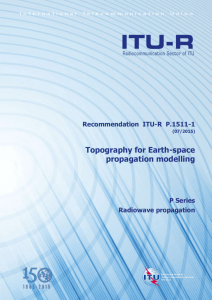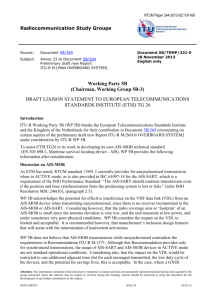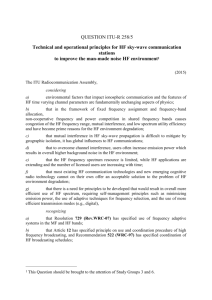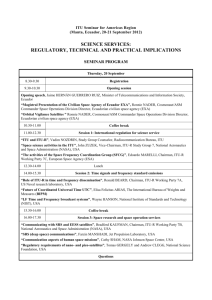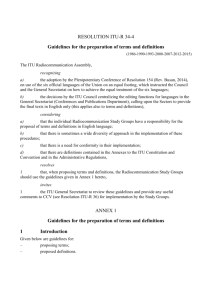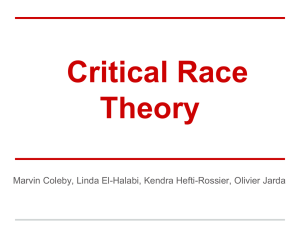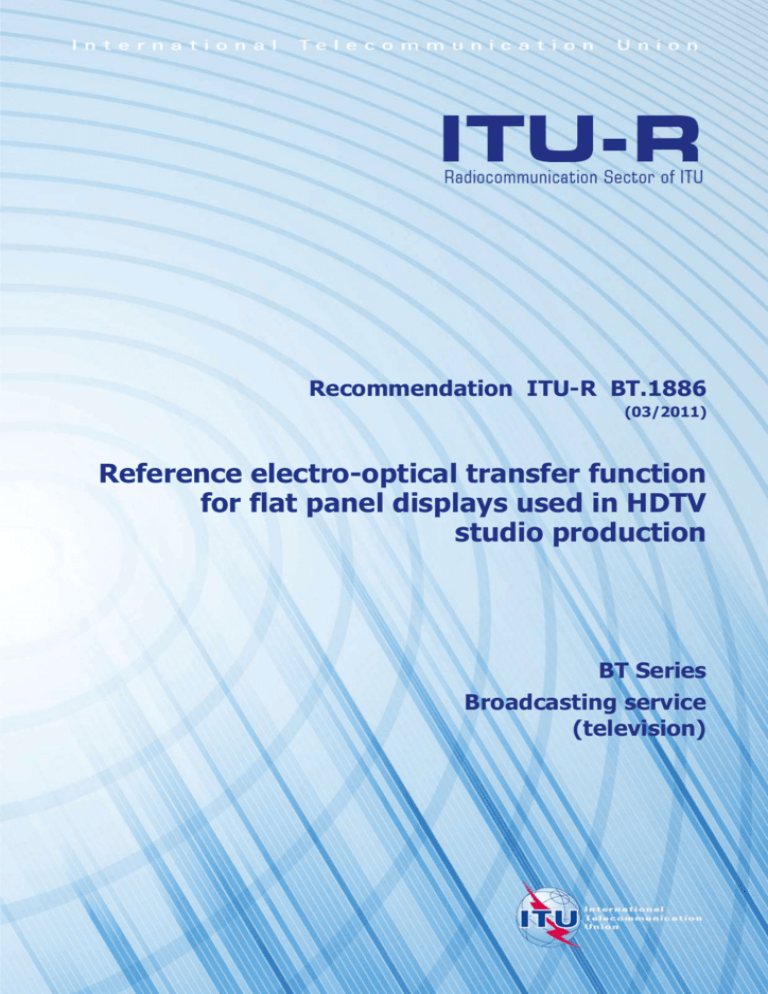
Recommendation ITU-R BT.1886
(03/2011)
Reference electro-optical transfer function
for flat panel displays used in HDTV
studio production
BT Series
Broadcasting service
(television)
ii
Rec. ITU-R BT.1886
Foreword
The role of the Radiocommunication Sector is to ensure the rational, equitable, efficient and economical use of the
radio-frequency spectrum by all radiocommunication services, including satellite services, and carry out studies without
limit of frequency range on the basis of which Recommendations are adopted.
The regulatory and policy functions of the Radiocommunication Sector are performed by World and Regional
Radiocommunication Conferences and Radiocommunication Assemblies supported by Study Groups.
Policy on Intellectual Property Right (IPR)
ITU-R policy on IPR is described in the Common Patent Policy for ITU-T/ITU-R/ISO/IEC referenced in Annex 1 of
Resolution ITU-R 1. Forms to be used for the submission of patent statements and licensing declarations by patent
holders are available from http://www.itu.int/ITU-R/go/patents/en where the Guidelines for Implementation of the
Common Patent Policy for ITU-T/ITU-R/ISO/IEC and the ITU-R patent information database can also be found.
Series of ITU-R Recommendations
(Also available online at http://www.itu.int/publ/R-REC/en)
Series
BO
BR
BS
BT
F
M
P
RA
RS
S
SA
SF
SM
SNG
TF
V
Title
Satellite delivery
Recording for production, archival and play-out; film for television
Broadcasting service (sound)
Broadcasting service (television)
Fixed service
Mobile, radiodetermination, amateur and related satellite services
Radiowave propagation
Radio astronomy
Remote sensing systems
Fixed-satellite service
Space applications and meteorology
Frequency sharing and coordination between fixed-satellite and fixed service systems
Spectrum management
Satellite news gathering
Time signals and frequency standards emissions
Vocabulary and related subjects
Note: This ITU-R Recommendation was approved in English under the procedure detailed in Resolution ITU-R 1.
Electronic Publication
Geneva, 2011
ITU 2011
All rights reserved. No part of this publication may be reproduced, by any means whatsoever, without written permission of ITU.
Rec. ITU-R BT.1886
1
RECOMMENDATION ITU-R BT.1886
Reference electro-optical transfer function for flat panel
displays1 used in HDTV studio production
(2011)
Scope
This Recommendation specifies the reference electro-optical transfer function (EOTF) that the
displays used in HDTV programme production should follow in order to facilitate consistent picture
presentation2. The reference EOTF is specified as a simple equation, with exponent function, based
on measured characteristics of the Cathode Ray Tube (CRT).
The ITU Radiocommunication Assembly,
considering
a)
that reference displays play a crucial role in television programme production as they are
used as reference for picture presentation;
b)
that the characteristics of reference displays should be unified to ensure consistent picture
presentation of programmes produced for use in broadcasting;
c)
that historically, picture presentation characteristics were determined based on Cathode Ray
Tube (CRT) characteristics, and the opto-electronic transfer characteristics were implicitly based on
the CRT physical characteristics;
e)
that CRT reference displays are no longer available;
f)
that the electro-optical transfer function (EOTF) of CRT displays differs amongst
manufacturers, amongst models, and amongst regions, as well as varying with the settings of
contrast and brightness;
g)
that for the consistency of picture presentation, it is desirable that newly introduced display
technologies have an EOTF that closely matches that of the CRT;
h)
that the reference EOTF for a non-CRT display has not been defined in any ITU-R
Recommendation;
j)
that Recommendation ITU-R BT.709, provides specifications for the opto-electronic
transfer characteristics at the source, and a common electro-optical transfer function should be
employed to display signals mastered to this format,
recommends
1
that the reference EOTF for displays used in HDTV production and programme interchange
should be the one specified in Annex 1;
1
May also include projectors and other display devices.
2
The term picture presentation is intended to indicate the monitoring of picture characteristics to ensure
that image characteristics do not vary between different signal sources, and different programme
segments.
2
Rec. ITU-R BT.1886
2
that an alternative EOTF may be used in some cases where programme interchange is not
required, a suggested equation is contained in informative Appendix 1.
Annex 1
Reference electro-optical transfer function
The reference EOTF is specified by the equation:
L a(max[( V b),0])
where:
L:
L W:
L B:
V:
:
a:
Screen luminance in cd/m2
Screen luminance for white
Screen luminance for black
Input video signal level (normalized, black at V = 0, to white at V = 1. For
content mastered per Recommendation ITU-R BT.7093, 10-bit digital code
values “D” map into values of V per the following equation: V = (D–64)/876
Exponent of power function, γ = 2.404
Variable for user gain (legacy “contrast” control)
a ( LW 1 / LB1 / )
b:
Variable for user black level lift (legacy “brightness” control)
b
LB1 /
LW 1 / LB1 /
Above variables a and b are derived by solving following equations in order that V = 1 gives
L = LW and that V = 0 gives L = LB:
LB a b
LW a (1 b)
NOTE 1 – This Recommendation defines the reference EOTF equation, if it is required to confirm that a
display device meets the reference equation it is recommended that the measurement be conducted in a dark
room.
3
For reference black, D = 64, for reference white, D = 940.
4
This value has been shown to be a satisfactory match to the legacy CRT display.
Rec. ITU-R BT.1886
3
Appendix 1
(Informative)
EOTF-CRT matching
The EOTF specified in Annex 1 is considered to be a satisfactory, but not exact, match to the
characteristic of an actual CRT. When it is desired to match a CRT, the Lw and LB parameters of the
EOTF can be set to the corresponding values of the CRT that are being matched. For moderate
black level settings, e.g. 0.1 cd/m2, setting the LB of the EOTF to 0.1 will give a satisfactory match
to the CRT. In the event the CRT is operated at a lower black level, e.g. 0.01 cd/m 2, the EOTF will
provide a better match with LB set to a lower value such as 0.0 cd/m2. When it is necessary to more
precisely match a flat panel display characteristic to a CRT, the alternative EOTF formulation
specified below may provide a solution.
An example of an alternative approximation of an EOTF of a CRT display
An example of an EOTF that has alternative characteristics of a CRT’s EOTF:
L k (Vc b)( 1 2 )[V b]2
for V Vc
L k [V b]1
for Vc V
where
Vc:
L:
L W:
V:
0.35, 1 = 2.6, 2 = 3.0
Screen luminance (cd/m2)
Screen luminance for white, reference setting is LW = 100 cd/m2
Input video signal level (normalized, black at 0, to white at 1. 10-bit digital
code values “D” map into values of V per the following equation:
V = (D-64)/876)
k:
b:
Coefficient for normalization (so that V = 1 gives white), (k = LW/[1 + b]1)
Variable for black level lift (legacy “brightness” control).
The value of b is set so that the calculated luminance can be the same as the
measurement data at input signal level 0.0183 (= (80-64)/876).
The value of b changes depending on “brightness” control.
4
Rec. ITU-R BT.1886
FIGURE 1
EOTFs: Black dot (measured data), Red line (reference EOTF),
Blue line (alternative EOTF equation, Vc: 0.35, 1 = 2.6, 2 = 3.0)
1
10
10
10
10
–1
–2
–3
–4
0.0
0.2
0.4
0.6
0.8
1.0
1886-01
Appendix 2
(Informative)
Historic overview
CRT displays have been used as the reference display in HDTV programme production and
monitoring for many years. Displays based on different physical technology are now being
employed to replace the aging CRT displays. It is important to specify the characteristics for this
next generation of display technologies so that consistent results may be achieved in future
programme production. It is useful for the EOTF specified for the new display technologies to
closely match the EOTF of the legacy CRT display. However, the legacy CRT EOTF was never
documented, as all CRTs naturally behaved similarly. This Recommendation specifies a reference
EOTF that should be employed in displays used in HDTV programme production.
While the image capture process of Recommendation ITU-R BT.709 had an optical to electrical
transfer function, there has never been an EOTF documented. This was due in part to the fact that
display devices until recently were all CRT devices which had somewhat consistent characteristics
device to device.
Rec. ITU-R BT.1886
5
This Recommendation does NOT change any signal parameters defined in Recommendation
ITU-R BT.709; legacy installations are not impacted.
Opto-electronic conversion Recommendation ITU-R BT.709
Item
Parameter
1.1
Opto-electronic transfer
characteristics before non-linear
precorrection
1.2
Overall opto-electronic transfer
characteristics at source
1.3
Chromaticity coordinates (CIE, 1931)
Primary
– Red (R)
– Green (G)
– Blue (B)
1.4
Value
Assumed linear
V 1.099 L0.45 – 0.099 for 1 L 0.018
V 4.500 L
for 0.018 L 0
where:
L: luminance of the image 0 L 1
V: corresponding electrical signal
x
y
0.640
0.300
0.150
0.330
0.600
0.060
Assumed chromaticity for equal
primary signals
(Reference white)
ER EG EB
D65
x
y
0.3127
0.3290
With the introduction of new display technologies which have entirely different characteristics to
the CRT displays, it is necessary to define the EOTF of new devices that emulate that of the CRT
displays. In measuring the EOTF of a large number of CRTs it was determined that the EOTF of the
CRT was in fact highly variable when the brightness/contrast was adjusted, it is therefore not
possible to 100% emulate CRT capability (or limitations).
Users of this Recommendation in combination with the new technologies should be able to achieve
a higher degree of image presentation repeatability than that offered in the past.


